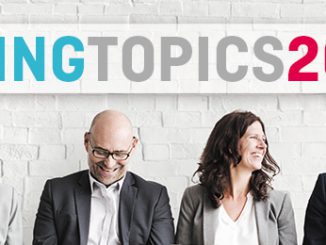
Jeanne Meister op forbes.com, januari 2017. De uitdaging voor HR in 2017 wordt het creëren van de nieuwe normaal voor HR: de beste employee experience. Kijk met een consumenten- en digitale bril naar je HR organisatie. HR werkt samen met Facility Management, IT, Marketing en Interne Communicatie voor een naadloze samenwerking.
In 2016, I wrote about the transformation happening in human resources and I called it the “Consumerization of HR,” referring to how companies create a social, mobile, and consumer-style experience for employees. Now, as we enter 2017, the next journey for HR leaders will be to apply a consumer and a digital lens to the HR function creating an employee experience that mirrors their bestcustomer experience.
The Future Workplace: Building A Consumer And Digital HR Organization
Today, almost every company is undergoing a digital transformation. Cloud and mobile computing, artificial intelligence, and increasing automation have created the potential to transform nearly every aspect of a business. A survey of CEOs conducted by Fortune asked whether they thought their company was a “technology company” and 67% of CEOs said YES!
The same can be said for forward looking HR departments like those at IBM and General Electric. HR leaders such as Diane Gherson at IBM, and Susan Peters at General Electric, are transforming HR to deliver an employee experience that is human centered, uses the latest digital technologies, and is personalized, compelling, and memorable.
According to Forrester, 47% percent of executives surveyed believe that by 2020, digital will have an impact on more than half their sales. We see how digital has transformed media, retail, transportation and education. Now it’s HR’s turn. Digital and consumer marketing are permeating new ways of recruiting, working, learning, and engaging employees.
Applying a consumer and digital lens is much more than just incorporating new solutions in HR. Being employee-centered and digital is about having a new mindset, plus a set of consumer-focused and technological skills to creating new HR solutions. Above all, it requires a belief in the power of leveraging the latest consumer technologies inside HR. This starts with how a company engages prospective new hires. Consider how Zulily, an e-commerce company selling clothing, toys, and home products, invites candidates applying for a job on its social media team to submit an Instagram post that best represents themselves and what they would bring to the team. Or consider how MasterCard, BMO Financial Group, Cisco, and Silicon Valley Bank develop new HR solutions by conducting hackathons to co-create new ways forward with employees.
2017 is the year to prepare for transforming HR to be agile, consumer-focused, and digital. The ten trends below will matter most this year.
1: Focus On Creating A Compelling Employee Experience
As Susan Peters, Senior Vice President, Human Resources at General Electric says, “We define employee experience simply as seeing the world through the eyes of our employees, staying connected, and being aware of their major milestones. In the last year we have appointed a Head of Employee Experience and we are developing a strategy to create an employee experience which takes into account the physical environment our employees work in, the tools and technologies that enable their productivity, and learning to achieve their best at work. All of this is part of continuously evolving our HR capabilities.”
HR leaders are leading this effort by reaching outside of the HR function to partner with heads of Real Estate, IT, Marketing, Internal Communications, and Global Citizenship to create one seamless employee and customer experience. In our Future Workplace and Beyond.com study entitled The Active Job Seeker Dilemma, we found that 83% of HR leaders said “employee experience” is either important or very important to their organization’s success, and they are investing more in training (56%), improving their work spaces (51%), and giving more rewards (47%). Companies are also driven to focus on creating a compelling employee experience as the war for talent heats up. Mercer predicts that 90% of employers anticipate more competition for talent, especially in India, North America, and Asia. So making the workplace an experience allows companies to embed their culture and values in the workplace and use this to recruit and retain top talent.
2. Use An Agile Approach To Recruit And Develop Employees
An agile approach is typically used in software development to operate with speed and manage unpredictability. This approach is now being used to recruit and develop employees. When Amber Grewal was the global head of talent acquisition at GE Digital (Amber is now the VP of Talent Acquisition at IBM) she led a transformation of talent acquisition by applying an agile approach used to develop software. In the process Grewal created a new role, “Agile Recruiting Scrum Master.” The result: recruiters were able to deliver top talent to clients within 2 to 6 weeks versus an average of 10-15 weeks. Agile is not only being applied to recruiting but also to learning and development. I’ve interviewed many heads of learning and identified a number who considered themselves intrapreneurs of the learning function rather than learning and development subject matter experts. What they did differently was apply an agile approach to corporate learning by making it easy for employees to find, rate, tag, and consume learning. They saw their job as learning curators rather than content creators. Companies like IBM, Visa, MasterCard, adidas, and General Electric, to name just a few, are adopting new intelligent digital platforms to create a Netflix-like experience for corporate learners.
3. Partner With Real Estate To Create Spaces That Promote Culture
In a TED talk, Susan Cain made the case that most workplaces are, “designed mostly for extroverts and their need for lots of stimulation.” She highlighted how introverts are highly talented individuals with a very different set of characteristics. So companies should ask, “How can we accommodate both our introverts and our extroverts in our workspaces?” Try asking yourself four simple questions regarding the workspace you have in your organization:
1. Where do you go to do your best work?
2. Where do you go to get the job done?
3. Where do you avoid meeting or working?
4. Where do you go to recharge?
Although a majority of American workers go to offices with open floor plans (70% of us, according to the International Facilities Management Association), companies are beginning to acknowledge that this isn’t always the best for getting work done. In fact, research from Steelcase conducted with a global sample of 12,480 employees across 17 countries documents that workers who have control over where and how they work, and are free to choose a workspace to fit their task at hand—either focused work or collaborative work—are 88% more engaged at work. The decision is not whether or not to design an open space, but rather how to give employees choice in where to work based upon the activity they are working on.
The HR takeaway: workspace is not just a building, but part of the HR agenda to extend the company’s culture and engage employees.
4) Apply a Consumer Marketing Lens to HR
With job candidates and employees empowered to provide instant feedback on employers, we are seeing the “yelpification” of the workplace, where, employees can rate a company’s culture and management just as they rate a hotel, restaurant, or movie. HR departments are applying a range of consumer marketing tools, such as design thinking, hackathons, and sentiment analysis to create a compelling employee experience. Paul Papas, global leader of IBM Interactive Experiences, says, “The last best experience that anyone has anywhere becomes the minimum expectation for the experiences they want everywhere.” This is leading companies such as IBM and Cisco to translate their relentless focus on customers to their employees. IBM uses design thinking and their own sentiment analysis tool, called Social Pulse, to reveal insights in re-imagining performance management. Cisco borrows the concept of hackathons, from the IT world, to create new HR products such as the YouBelong@Cisco app to aid new hires and their managers in navigating the first weeks at Cisco, and Ask Alex: Your Personal Intelligent Compass, a voice command app offering fast and personalized information on a range of HR questions such as vacation policy, expense reports, and health related questions.
Lees hier verder voor de andere 6 trends:
5. Pilot Chatbots In HR
6. Plan For A Blended Workforce
7. Develop Career Mobility Options
8. Invest In Employee Wellness
9. Focus On Team Development, Not Just Individual Development
10. Prepare For New Roles In HR
Wil je meer inspiratie over Gelukkig Werken en de beste Employee Experience? Kijk dan voor meer informatie en de mogelijkheden bij workshops & opleidingen of contacteer het Happiness Bureau.



